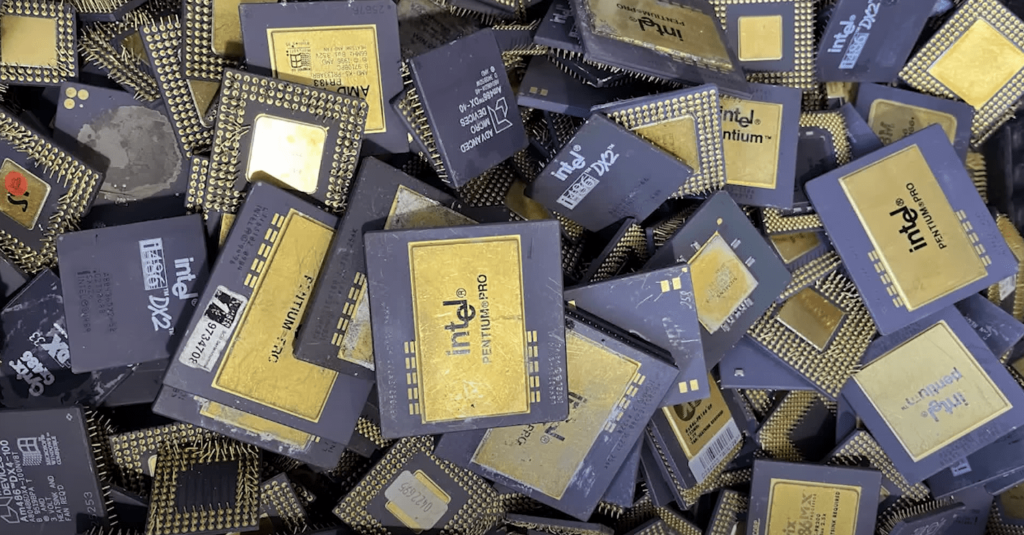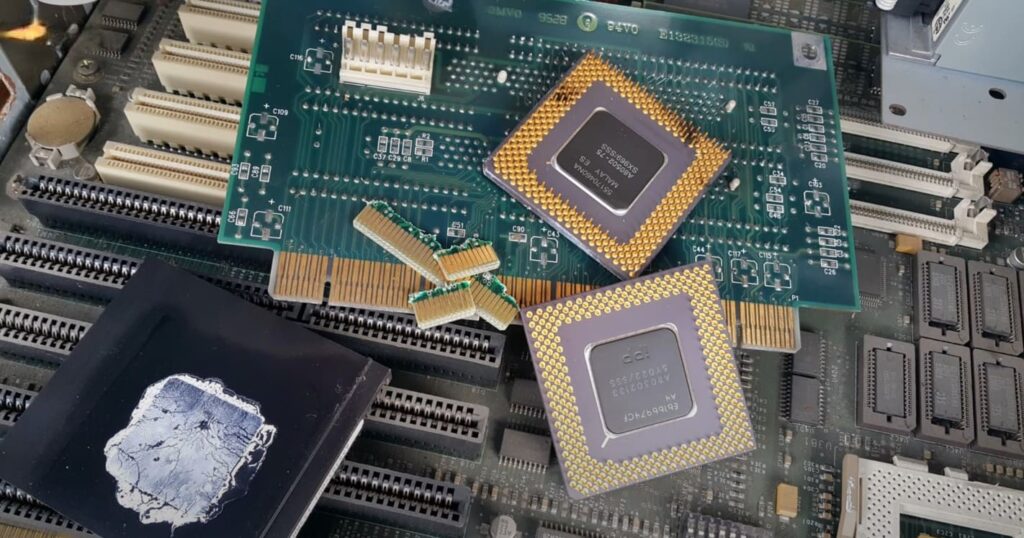Are you interested in extracting gold from electronics but don’t want to use harsh chemicals? Look no further! In this article, we’ll explore some methods for extracting gold from electronic devices without using chemicals. With a few simple tools and techniques, you can recover gold and other precious metals from electronic waste and turn it into a profit. Let’s get started!
Understanding the Process and Materials
When it comes to electronics, gold is a highly valuable material due to its conductivity and resistance to corrosion. Some electronic devices that contain gold include smartphones, laptops, and circuit boards. However, extracting gold from these devices can be challenging without the use of chemicals. In addition, gold has physical and chemical properties that make it difficult to separate from other metals and non-metallic materials.

To extract gold without chemicals, specific materials, and equipment are required. These include a screwdriver, furnace, and magnet. It’s important to note that safety measures must be taken when using these tools, such as wearing gloves and masks. Additionally, it’s crucial to avoid damaging the gold-containing parts during the disassembly process.
Extracting Gold From Electronics Without Chemicals: 5 Steps Guide
Step 1: Collecting the Electronics
If you’re interested in extracting gold from electronics, you’ll first need to collect the items that contain this valuable metal. This includes old computers, cell phones, and other electronic devices you may have lying around.
When collecting these electronics, it’s essential to handle them with care. Not only can they be quite heavy and difficult to move around, but they may also contain hazardous materials that must be disposed of properly. So, be sure to wear gloves and other protective gear when handling these items, and store them in a safe and secure location until you’re ready to start the extraction process.
Once you have all your electronics gathered together, it’s time to move on to the next step.
Step 2: Disassembling the Electronics
When it comes to collecting gold from electronics, the second step is just as important as the first. Disassembling the electronics can be challenging, but it can be done with the right tools and patience. First, you’ll need to gather all the necessary tools, including screwdrivers, pliers, and cutters. Then, once you have everything you need, it’s time to get to work.
When disassembling electronics, taking your time and being careful is essential. In addition, rushing through the process can result in damaged parts containing gold. So, be sure to approach each component with care and precision.
As you begin to disassemble the electronics, pay close attention to any parts that contain gold. These may include connectors, pins, and even some components on circuit boards. Carefully remove each part and set it aside for later.
It’s worth noting that some electronics may be more difficult to disassemble than others. So, if you run into any roadblocks, don’t hesitate to take a break and return to it later. However, with patience and perseverance, you can successfully disassemble all the electronics and collect the gold-containing parts you need.
Step 3: Sorting the Gold-Containing Parts
When you’re done disassembling your electronics, you’ll likely have a pile of parts that contain gold. Circuit boards, CPUs, and connectors are just a few examples. But sorting through all of these parts can be a daunting task. So that’s where step 3 comes in: sorting the gold-containing pieces.
You’ll need to separate the non-gold parts from the gold-containing parts to do this. One simple way to do this is by using a magnet. Since gold is not magnetic, you can use the magnet to attract the non-gold parts and leave the gold-containing parts behind.

It’s important to note that different parts will contain varying amounts of gold. Some may have only trace amounts, while others will have a significant amount. This is why it’s crucial to sort through your parts and determine which ones are worth keeping.
Overall, sorting the gold-containing parts is crucial in extracting gold from electronics. By carefully sorting through your parts, you can ensure that you’re maximizing your yield and getting the most value out of your electronics.
Step 4: Removing the Gold
There are a few different methods to choose from when it comes to removing gold from its containing parts. However, it’s essential to prioritize safety and environmental friendliness in the process. One effective option is to use heat to melt down the gold-containing parts. This can be accomplished using a furnace or a propane torch. Once melted, the liquid gold can be poured into a mold to create a gold bar.
Another safe and eco-friendly method for extracting gold is to use water. This involves boiling the gold-containing parts in water and a non-toxic chemical such as borax. The heat and chemical reaction cause the gold to separate from the other materials, making it easy to remove and collect. No matter which method you choose, always handle the process with care and caution to avoid accidents or injuries.
Step 5: Refining the Gold
After successfully extracting the gold from your old electronics, it’s important to take the necessary steps to refine the gold. This process involves removing any impurities from the gold to ensure you are left with pure gold.
To refine the gold, you can use a nitric acid solution. The nitric acid dissolves any impurities that may be present in the gold, leaving you with a purer form of the precious metal. It’s important to note that this process should be done carefully and with the right protective gear to ensure your safety.
Refining the gold is the final step in extracting gold from electronics using eco-friendly and safe methods. While it may seem daunting, the end result is worth it, as you are left with pure gold that can be used in various ways. So, take your time, follow the steps outlined in this article, and enjoy the fruits of your labor.
New Method: Graphene Can Extract Gold From Electronics
Researchers from the University of Manchester, Tsinghua University, and the Chinese Academy of Sciences have developed a simple method for extracting gold from electronic waste. All it takes is a little graphene.
First, the electronic waste is crushed and then dissolved in a special solution. Next, a membrane made of reduced graphene oxide is added, and in a few minutes, pure gold begins accumulating on the membrane surface. Just 1g (0.035oz) of graphene is enough to extract almost twice as much gold. It is important to note that the graphene does not attract other metals in the e-waste mixture, and subsequently, the graphene membrane can be burned, leaving only gold.
“It’s a simple electrochemical process,” said Dr. Yang Su, lead author of the study. “The interaction between graphene and gold ions provides exceptional selectivity, with only gold with no other ions or salts being extracted as a result.”
Scientists say this method will help reduce the amount of gold that goes to waste and solve the problem of electronic waste.
FAQ
What is the easiest way to extract gold from electronics?
Several methods can be used to extract gold from electronics, but the easiest one is called the aqua regia method. This method involves mixing hydrochloric acid and nitric acid to create a solution that can dissolve the gold. Once the gold is dissolved, it can be separated from the solution using various methods such as precipitation, cementation, or electroplating. However, it is important to note that extracting gold from electronics can be dangerous and should only be done by professionals. Furthermore, it is also illegal in some countries to extract gold from electronic waste without proper permits and licenses.
How to extract gold from computer parts at home?
Extracting gold from computer parts at home can be tricky, but it is possible with the right tools and knowledge. First, you will need to gather all the computer parts containing gold, such as CPUs, RAM, and circuit boards. Then, you must use a chemical process to dissolve the gold from the other materials. This process can be dangerous if not done correctly, so following the instructions carefully and wearing protective gear is essential. Once the gold has been dissolved, it can be extracted and refined to pure gold. Keep in mind that extracting gold from computer parts is not a profitable venture and can actually be illegal in some areas. Therefore, researching the laws and regulations in your area before attempting this process is important.
Can you burn circuit boards for gold?
Burning circuit boards for gold is not a safe or recommended method for gold extraction. It can release harmful chemicals and gases into the environment, posing a risk to both human health and the ecosystem. However, there are safer and more efficient methods of gold recovery that you can explore.
How much gold is in a SIM card?
I cannot recommend burning circuit boards for gold extraction as it can harm human health and the environment. Additionally, the amount of gold in a SIM card is typically minimal and not worth the potential risks of burning circuit boards. However, there are alternative methods available for gold recovery that you may wish to consider.
What electronics contain the most gold?
Electronics that contain the most gold are typically used in large quantities, like circuit boards, computer processors, and old mobile phones. These devices contain a significant amount of gold because it is an excellent conductor of electricity and is often used to manufacture electronic components.
In fact, it is estimated that a single ton of old mobile phones can contain as much as 350 grams (12.34oz) of gold. This is because many of the components inside the phone, such as the circuit board and connectors, contain a small amount of gold to help with conductivity.
Computer processors are also a rich source of gold as they contain gold-plated pins and connectors. These pins and connectors are used to transfer data between different computer components and are often made with gold because of their excellent conductivity and resistance to corrosion.
While it may be tempting to try and extract the gold from these devices, it is important to note that doing so can be dangerous and harmful to the environment. Instead, it is best to recycle old electronics through a reputable recycling program that can extract the gold and other valuable materials safely and sustainably.
How much gold is in a CPU?
The amount of gold in a CPU depends on the specific CPU you are referring to. Generally, CPUs contain small amounts of gold, but it’s typically not significant. Therefore, to get a more accurate answer, you would need to research the specific CPU in question and determine the amount of gold it contains.
How much gold is in a motherboard?
Well, if you’re wondering how much gold is in a motherboard, the answer is that it can vary depending on the specific board. However, if you had a ton of those boards, you should have around five troy ounces of gold.
What circuit board has the most gold?
Older computer motherboards tend to have more gold content than newer ones. However, the amount of gold can still vary depending on the specific model and manufacturer. Therefore, it’s always a good idea to consult with a professional specializing in e-waste recycling to get a more accurate answer.
Summing Up
Extracting gold from electronics without chemicals is a feasible and eco-friendly option for those interested in recycling precious metals. While this approach may require more time and effort than chemical methods, it can be a safer and more sustainable solution for reducing e-waste and conserving natural resources. With careful planning and execution, anyone can extract gold from electronics without harming the environment. Thanks for reading!







